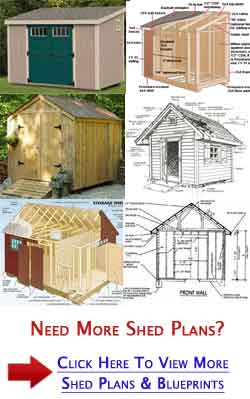

 ar.inspiredpencil.com
ar.inspiredpencil.com Opening: Introduction to Building a DIY A-Frame Shed Are you looking for a simple and cost-effective way to add storage or a small workshop to your backyard? An A-frame shed is an excellent option! Its straightforward design makes it a manageable DIY project, even for those with limited construction experience. This post will guide you through the process, step-by-step, so you can build your own sturdy and stylish A-frame shed.
Step 1: Planning and Preparation Before you start hammering and sawing, careful planning is crucial. Decide on the Size: Determine the dimensions of your shed based on your needs and available space. Consider local building codes and any permit requirements. A common size is 8' x 12', but you can adjust this to suit your circumstances. Create a Detailed Plan: Sketch out the design of your shed, including the dimensions, placement of the door and windows (if desired), and the angle of the roof. There are numerous free A-frame shed plans available online; adapt one to your specific needs or create your own. Gather Materials: Make a comprehensive list of all the materials you'll need, including lumber (for the frame, sheathing, and roof), roofing materials (shingles, metal sheets, etc.), fasteners (nails, screws), a door, and any windows. Calculate the quantities carefully to avoid running out mid-project. Acquire Tools: Ensure you have all the necessary tools, such as a saw (circular saw or miter saw), drill, level, square, measuring tape, hammer, safety glasses, and work gloves.
Step 2: Building the Foundation A solid foundation is essential for the stability and longevity of your shed. Prepare the Site: Clear the area where the shed will be located, removing any vegetation, rocks, and debris. Level the ground as much as possible. Construct the Foundation: There are several foundation options, including a gravel pad, concrete slab, or pressure-treated lumber frame. A simple and cost-effective option is a gravel pad. Lay down a layer of landscape fabric to prevent weeds from growing, then spread a layer of gravel at least 4 inches thick. Compact the gravel using a tamper.
Step 3: Constructing the A-Frames The A-frames form the structural skeleton of your shed. Cut the Lumber: Cut the lumber according to your plan, creating the angled top pieces and the base pieces of each A-frame. Ensure the angles are precise for a stable and uniform structure. Assemble the Frames: Assemble each A-frame by connecting the angled top pieces to the base pieces, forming an "A" shape. Use screws or nails to securely fasten the pieces together. Reinforce the joints with gusset plates or plywood triangles for added strength. Raise the Frames: Stand the A-frames upright, spacing them evenly according to your plan. Temporarily brace the frames with lumber to keep them stable while you attach the ridge beam.
Step 4: Installing the Ridge Beam and Connecting the Frames The ridge beam connects the A-frames and provides structural support. Attach the Ridge Beam: Position the ridge beam along the top of the A-frames, connecting them together. Securely fasten the ridge beam to each A-frame with screws or nails. Add Horizontal Supports: Install horizontal support beams between the A-frames, typically at the base and mid-height. These beams will further stabilize the structure and provide a framework for attaching the sheathing.
Step 5: Sheathing the Walls and Roof Sheathing provides a solid surface for attaching the roofing and siding. Cut the Sheathing: Cut plywood or OSB sheathing to fit the walls and roof of the shed. Attach the Sheathing: Attach the sheathing to the frame, using screws or nails. Start at the bottom and work your way up, overlapping the seams for added strength and weather resistance. Ensure the sheathing is securely fastened to the frame, providing a solid base for the roofing and siding.
Step 6: Installing the Roofing Protect your shed from the elements with a durable roofing system. Choose Roofing Material: Select your roofing material, such as asphalt shingles, metal sheets, or wood shakes. Consider your budget, climate, and desired aesthetic. Install Roofing Underlayment: Apply roofing underlayment (felt paper or synthetic underlayment) to the sheathing to provide an extra layer of protection against moisture. Install the Roofing Material: Install the chosen roofing material according to the manufacturer's instructions. Overlap the shingles or sheets properly to ensure a watertight seal.
Step 7: Adding the Door and Windows (Optional) A door and windows provide access and natural light. Frame the Door and Window Openings: If you plan to install a door and windows, frame the openings with lumber, ensuring they are properly sized for the chosen door and window units. Install the Door and Windows: Install the door and window units, following the manufacturer's instructions. Ensure they are properly sealed to prevent drafts and leaks.
Step 8: Siding and Finishing Touches Siding enhances the appearance and provides additional weather protection. Install Siding: Install siding on the exterior of the shed, using materials such as wood siding, vinyl siding, or metal siding. Choose a siding that complements the roofing and provides adequate weather protection. Add Trim: Add trim around the door, windows, and corners of the shed to give it a finished look. Paint or Stain: Paint or stain the shed to protect the wood and enhance its appearance.
Conclusion: Enjoy Your New A-Frame Shed Congratulations! You've successfully built your own A-frame shed. With proper planning, careful construction, and attention to detail, you can create a functional and attractive storage space or workshop that will last for years to come. Remember to regularly inspect and maintain your shed to ensure its longevity and structural integrity. Enjoy your new A-frame shed!
A Letter Alphabet
 ar.inspiredpencil.com
ar.inspiredpencil.com Download Letter, Alphabet, A. Royalty-free Vector Graphic
 pixabay.com
pixabay.com Capital Letter A
 ar.inspiredpencil.com
ar.inspiredpencil.com



0 komentar:
Posting Komentar